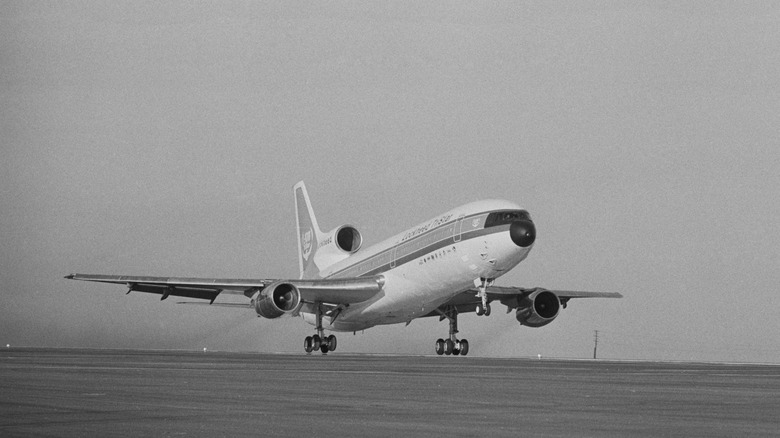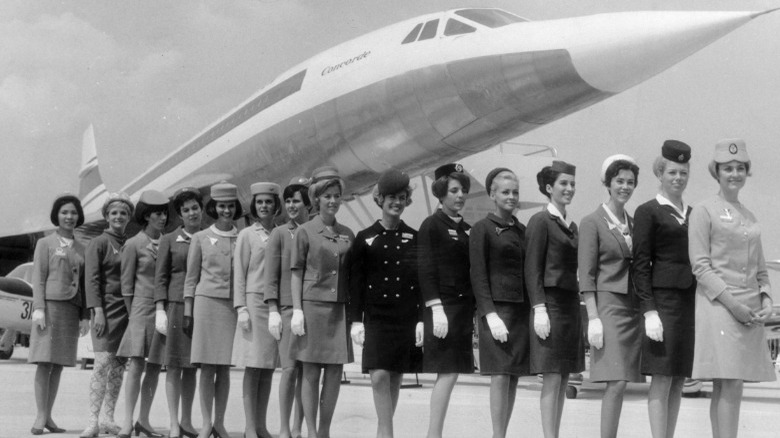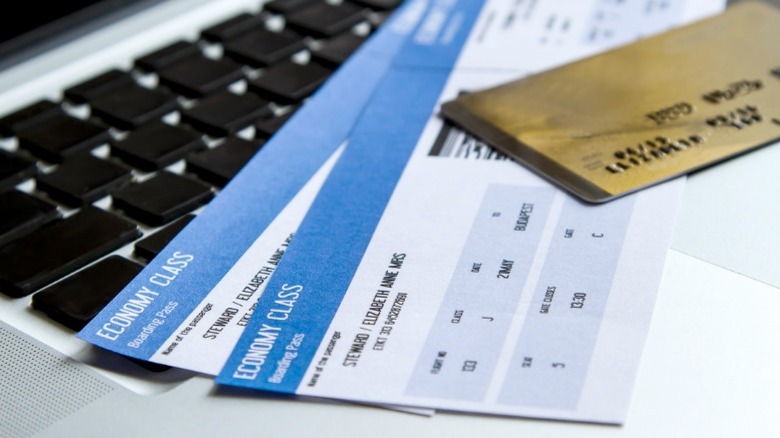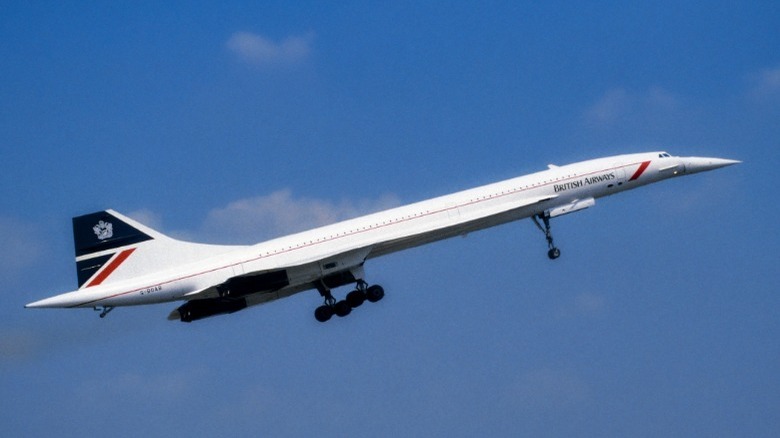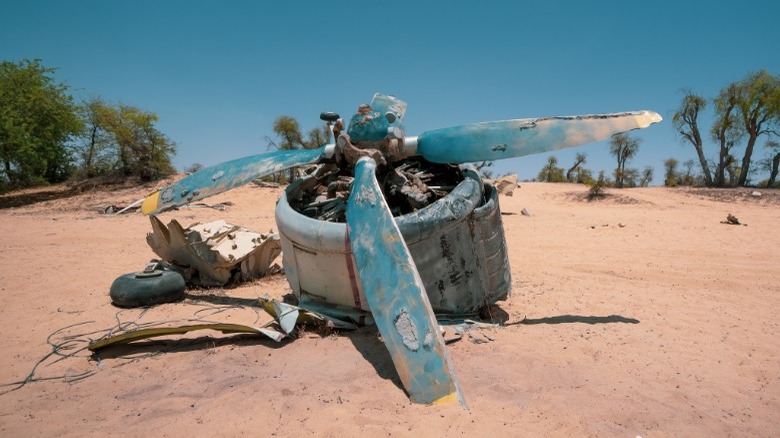What Airline Travel Was Like 50 Years Ago
During the COVID-19 pandemic, many of us have been yearning to travel abroad. Yet some of us may have forgotten the many stressors of flying. We may neglect to remember the lines, the random ticket prices, the pitiful leg room, and the screaming children. Then there are the repressed memories of lost luggage and last-minute cancellations. Frankly, air travel can be a nightmare — but it wasn't always this way.
Passengers from the late '60s and early '70s may have flown at a time when flying was less safe, but they also enjoyed carefree check-ins, abundant leg room, and all the food and drink they could expect from a pricy restaurant. However, passengers were also approaching a time of change. The glamour of the 1950s and early 1960s was over. Flying was becoming a means of transport, not a social excursion. Here is what airline travel was like 50 years ago.
By the early 1970s, air travel was becoming commonplace
The 1950s are often referred to as the golden age of air travel. According to Insider, a flight across the United States was a cause to dress up. Women would be in their best dress while men would be sure to don a flannel suit. Then there was the food, which was in stark contrast to today's processed meals. Passengers could expect roast beef, fresh lobster, prime rib, and an assortment of booze.
However, by the 1960s and early 1970s, attitudes and standards were shifting. The novelty was wearing off. With a country as large as the United States, passengers were starting to see air travel as a necessary function rather than an event. Sartorial standards were higher than today's torn jeans, sweat pants, and trainers, but the values of the so-called golden age were passing. Leather jackets and bell-bottom jeans were replacing the three-piece suits and pencil skirts.
The food was still better, but modern standards were creeping in
According to The Guardian, airline food in the 1970s included caviar, turtle soup, a variety of entrées, dessert, fresh fruit, and drinks such as champagne, burgundy, and bordeaux. However, modest meals were on the rise. Vanity Fair showed a typical meal aboard British European Airways from around the same time, which in this case was a roast beef sandwich with tomatoes, gherkins, lemon, and a chocolate mini roll on the side. You may also note that passengers had access to metal cutlery rather than the brittle plastic utensils of modern aviation.
The idea of caviar and champagne may seem appealing to you, but such extravagance may be wasted on a plane. This is because background noise, dry air, and the pressurized cabin can lower our ability to taste sweet and salty flavours by up to 30%, according to Insider. Apparently, the cabin pressure reduces the oxygen in our blood and the dry air dries out our nasal passages, which combine to reduce our sense of smell by so much that airlines have altered their recipes.
The Jumbo Jet was a new innovation
On January 22, 1970, the 747 "Jumbo Jet" made its first commercial flight from New York to London (via Northwestern University). Developed by Boeing in the mid-1960s, the 747-100 was the first variant of the aircraft, and it boasted some immense statistics. According to Modern Airliners, the 747-100 was 231 feet in length, 738,000 pounds in weight, and had a wingspan of 195 feet, which is longer than the Wright brothers' entire first flight, which covered 120 feet of a North Carolina beach on December 17, 1903 (via Eyewitness to History).
The vast airliner was the product of a conversation between Boeing president William Allen and Pan Am president Juan Trippe in December 1965. The agreement was that if Boeing built them, Pan Am would buy them, and they did. In April 1966, Pan Am bought 25 planes at $20 million each, which is some $400 million in total. That's roughly $3.4 billion in 2022 dollars, according to US Inflation Calculator.
The 747 has been in service since 1970, yet its days are numbered according to aerospace expert Dan Reed, who wrote, "The 747 was never a particularly profitable aircraft for airlines, even in good times ... sales [went] into a slide in the 1980 [sic] from which they never really ... recovered." The cost of operating the behemoth was made plain in 2020, when British Airways retired their entire 747 fleet (via News Atlas).
Security had only just become mandatory
According to Insider, security screenings only became a requirement in 1973, when rising passenger numbers demanded extra security. The Huffington Post wrote that before 1970, passengers could travel with no form of ID. Also, the check in process was a world away from the rigorous procedures of contemporary air travel. With only 30 minutes to spare, passengers could walk right up to their gate with friends and family to see them off.
It's surprising that it took the airline industry so long to implement serious security checks, as the period from 1961 to 1972 are sometimes referred to as the "golden age of airline hijackings," according to IBM. Author Brendan Koerner wrote that hijackings reached their peak between 1968 and 1972, a period in which hijackings occurred roughly once per week. The typical hijacker demand was that they be flown to Cuba, where they expected to be heralded by Fidel Castro's communist regime.
The first method of preventing these hijackings was the implementation of metal detectors and X-ray machines, which were used in the American prison system. Senator George Smathers said, "I see no reason why similar devices couldn't be installed at airport check-in gates to determine whether passengers are carrying guns or other weapons just prior to emplaning." The technology worked in airports, too, and many passengers indicated that they were reassured to see such security measures. So on January 5, 1973, the FAA mandated physical screenings for passengers and their luggage.
Air hostesses were hired based on appearance
50 years ago, air hostesses were expected to look a certain way. Former Pan Am flight attendant Patti Baker told ABC15 Arizona that she and her colleagues were hired according to their weight and height and would have to weigh themselves to ensure they weren't putting on weight. She was also required to keep her hair at shoulder length, polish her shoes, press her uniform, and polish her nails, all of which had to be checked by a supervisor.
An air hostess job ad in the New York Times reads (via Telegraph), "A high school graduate, single (widows and divorcees with no children considered), 20 years of age (girls 19 1/2 may apply for future consideration). 5'2" but no more than 5'9", weight 105 to 135 in proportion to height and have at least 20/40 vision without glasses."
In an Observer feature written by Eric Clark in 1970, the journalist observed that little had changed, "Overweight girls are out. Airlines don't usually take girls who wear dentures, or spectacles, and none would take a girls with a pronounced accent."
Prices were high and set by the government
According to Simple Flying, air fares were regulated by the Civil Aeronautics Board (CAB). The government authority decided everything, from routes to airlines' very existence (via The Atlantic). This meant that airlines' main areas of competition were food, cabin crew quality, and flight frequency.
This state capitalism business model worked until the energy crisis in the early 1970s, namely the oil embargo of 1973 – 1974. With airline prices already high, the government realized that CAB's leadership could not remain economically viable, so President Jimmy Carter began the process of deregulation with the 1978 Airline Deregulation Act (via EconLib). The policy has worked, reducing the price of U.S. domestic flights by roughly 50% from 1978 to 2013.
In the early 1970s, however, this age of budget travel was still a few years off, so passengers were still paying a premium for the leg room, fresh food, and general convenience that was about to be completely transformed by the free market.
Concorde made its first flight on September 26, 1973
The legendary Concorde supersonic jet made its first flight on March 2, 1969 (via Britannica). An Anglo-French project, Concorde was operated by British Airways and Air France and its commercial routes; its service began on January 21, 1976, and flights included London and Paris to Rio de Janeiro, Miami, Caracas, Bahrain, Washington D.C., and New York City, which became its defining route.
Concorde could fly between London and New York City in just 3 hours, with the fastest ever crossing taking just 2 hours and 52 minutes, according to Forbes. That is over 60% faster than the average flight time, which Finance estimates at 7 hours and 55 minutes.
A report from British Pathe in 1969 captured the excitement of Corncorde, which became an instant marvel of national pride. Popular though it was, the plane struggled to turn a profit and had to be supported by the British and French governments. The prices were too high and the passengers too few. Then there was Air France flight 4590, which crashed into a hotel after striking debris on the runway, killing all 109 people on board and 4 others in the hotel. Sadly, Concorde made its last flight in October 2003. British broadcaster Jeremy Clarkson wrote an emotional obituary, describing Concorde's cancellation as, "one giant leap backwards for mankind."
Smoking wasn't a problem
Guardian writer Juliana Piskorz described how the gourmet food of 1970s air travel would be, "Wolfed down in a mushroom cloud of second-hand cigarette smoke." In fact, on airliners, smoking a cigarette was as common as ordering a drink, according to Insider. Before 1973, passengers were free to smoke in their seats at will, no matter where they were on the plane. For the next 27 years, passengers could choose between smoking and non-smoking sections, a disctintion that was abolished in 2000, when the federal government banned all smoking on flights in and bound for the United States.
This legislation was part of a marked downward trend in U.S. tobacco consumption. According to the American Lung Association, over 37% of the American population smoked in 1970. By the year 2000, this figure had dropped to 23.3%. In 2018, that figure had dropped another 10% to just 13.7%.
Flying was more dangerous
According to The Week, an average of 68 commercial planes crashed each year in the 1970s, killing 1,676 people. Among these was the Tenerife Disaster, which remains the worst ever aviation accident (via Historynet). The Tenerife Disaster occurred not in the sky, but on the runway of Los Rodeos Airport, where two 747s — one KLM, the other Pan Am — collided in thick fog, killing 583 people.
Of course, this was a worst case scenario. But the tragedy in Tenerife reflected an industry that was generally more dangerous than it is today. Thankfully, the ensuing decades would see the introduction of GPS, aircraft avoidance systems, and ground-proximity alarms. According to pilot Patrick Smith, leading manufacturers such as Boeing and Airbus have, "engineered out the common causes of accidents" (via The Week).
Innovations in airline technology have produced statistics very different to those 50 years ago. For example, in 2019, there were eight fatal aviation accidents, killing 257 people, and in 2020, there were only five (via Independent). Aviation expert Carl Rochelle put it very reassuringly when he said, "The most dangerous part of your airline flight is the trip to the airport."
Low-cost airlines emerged
Pasengers of the 1970s could only dream of today's prices, yet the seeds of budget airlines were sown in their era. Southwest Airways was established in the late 1960s, and it had several unorthodox methods of attracting customers. According to USA Today, Southwest offered customers who bought their $26 tickets a bottle of fancy liquor, which proved to be a successful campaign that boosted not just their finances but their image, too. This ploy managed to put a small dent in the competitors, Braniff Airways and Texas International, both of which enjoyed greater resources and infrastructure. Today, Southwest is one of America's leading budget airlines.
In Britain, Sir Freddie Laker founded Laker Airways in 1966 (via Historynet) and introduced budget transatlantic flights in 1977. Guardian obituarist Dennis Barker described Laker as, "the first man to break the power of the big airlines by introducing vastly cheaper fares which opened up much of the world to people who previously couldn't afford air travel." Laker is credited as a leading pioneer of budget airlines, laying the blueprint for European carriers such as EasyJet, Ryanair, Eurowings, and Norwegian.
The 1973 oil crisis hit airlines hard
The 1973 oil crisis was a pivotal moment in aviation history. The embargo was imposed by Organization of Arab Petroleum Exporting Countries (OAPEC) on countries that supported Israel during the Yom Kippur War, which included the U.K., USA, Canada, Japan, and the Netherlands (via Insights). The embargo caused the price of oil to rise by some 300%, forcing airlines to cut costs, such as cancelling unpopular routes, reducing the weight of their aircraft, and forgoing paintjobs (via Stacker).
According to Boeing, the oil embargo expedited the nascent trends in the aviation industry. Growing passenger numbers meants that "fewer frills," narrower aisles, and tighter seats were all but certain — the cash crung oil embargo just sped it up. The most enduring legacy is the progress made in fuel efficiency. According to the International Council on Clean Transportation, the average fuel burn of new aircraft fell roughly 45% between 1968 and 2014. Most of this reduction occurred in the 1980s as airliners began to introduce new technologies that addressed the threats posed by oil embargos.
